| Pages:
1
..
5
6
7
8
9
..
18 |
Hydrazine H2SO4
Harmless

Posts: 13
Registered: 13-4-2011
Member Is Offline
Mood: No Mood
|
|
Hydrazine Poisoning
I am making a separate post because I want this to be noticed.
This may make me look sort of foolish, but I don't mind. In one of my earlier experiments when I was freebasing Hydrazine Sulfate by Rosco's method
with the water only (but in super small scale), I got a couple whiffs of Hydrazine.
It is also important to note that my reaction vessel wasn't sealed like Rosco's instructions suggested it should be.
The problem with small batches is that they have very little water and a lot of surface area. If the reaction is quite warm (and this one is), the
few mL of water will evaporate very quickly. Without the water to hold the Hydrazine in solution, and to keep the temperature low enough that the
Hydrazine has lower vapor pressure, You can get gassed with Hydrazine! Things can happen very quickly with a small batch!
On one of my earlier 3g batches I was using just water and Sodium Hydroxide to do the freebasing. I added the NaOH a little too fast maybe, and wasn't
paying attention as much as I should have. The water mostly all evaporated (the whole 3 mL or whatever it was), and then Hydrazine fumes started
coming off of the very warm mixture. I quickly added water but I had already sucked up some vapors. That was six days ago. I felt pretty rough for the
first few. Mostly just a weird headache and a really sore throat. I am feeling much better for the most part the last day or so, but my throat is
still pretty sore.
I am not saying don't experiment with this stuff. I still am going to, but I definitely learned a lesson the hard way.
[Edited on 23-4-2011 by Hydrazine H2SO4]
|
|
|
Rosco Bodine
Banned
Posts: 6370
Registered: 29-9-2004
Member Is Offline
Mood: analytical
|
|
Haji here, your Tech Support service representative for banishment of death fears.
Please understand your prayer to heaven was heard, but in these times of economic distress, austerity measures have forced the redirection of prayer
response fulfillment services to outsourced contractors in India 
http://www.youtube.com/watch?v=oHQs19sPdFE&fmt=18
|
|
|
Hydrazine H2SO4
Harmless

Posts: 13
Registered: 13-4-2011
Member Is Offline
Mood: No Mood
|
|
I think I'm going to make it, but I am glad that Rosco is praying for me.
Seriously it was a pretty dumb thing to do. When I am into an experiment I sometimes get a little overenthusiastic, and not think things through
enough. As long as I didn't do myself a lot of harm I did learn a lot ,and I certainly understand this chemical a lot better than I did a couple of
weeks ago.
I have to say though that this stuff seems to have a worse effect on me personally than nitric oxides, but then again I am not sure of the dose I took
either.
I think the big thing with my sore throat is that it is already sensitized. I have pretty bad gerd most of the time, so it doesn't take much to get my
throat inflamed. I tend to be kind of sensitive to many chemicals as well.
Rosco, a few posts back I posted a picture of a small Silver Azide yeild and it was quite dark colored. I am pretty sure it was because of the NaOH
also in solution with NaN3 used. I was reading through some of the old Rogue Sci stuff by Microtek and I think he said that the NaOH would cause
Silver Hydroxide to form. There shouldn't be any NaOH in a Silver Azide synthesis right? Do you use NaOH in a Lead Azide synthesis?
BTW Rosco, you and I used to discuss Picric Acid in another thread. Well mostly I was picking your brain, but sometimes I had a few good ideas.
[Edited on 25-4-2011 by Hydrazine H2SO4]
|
|
|
Rosco Bodine
Banned
Posts: 6370
Registered: 29-9-2004
Member Is Offline
Mood: analytical
|
|
Neutral azides are made by double decomposition using neutral salts. If there
is a deliberate intent to form a basic azide or a normal-basic double salt or clathrate that may be accomplished at some point by use of NaOH or other
base
in a very precisely calculated quantity. For inhalation safety reasons to avoid the formation of hydrazoic acid vapors as might occur on pH going too
low inadvertantly during a reaction intended to produce the normal neutral azide, a trace amount of NaOH may be used to keep the pH slightly basic.
|
|
|
Hydrazine H2SO4
Harmless

Posts: 13
Registered: 13-4-2011
Member Is Offline
Mood: No Mood
|
|
Thanks Rosco.
I just downloaded a great book on azides, Organic Azides Syntheses and Applications, published by Wiley in 2010. It can be downloaded for free. In
chapter two it shows the two main routes to sodium azide, and the second method is the one we have been using except they use ethyl nitrite instead of
isopropyl nitrite. Apparently it is called the Curtius synthesis of Sodium Azide.
2NaNO2 + 2C2H5OH + H2SO4 ---> 2C2H5ONO + Na2SO4 + 2H2O (1)
C2H5ONO + N2H4.H2O + NaOH ---> NaN3 + C2H5OH + 3H2O (2)
I also wanted to note that I was using H2SO4 to make the IPN the first few times, then I tried HCl and it is a much smoother process. With H2SO4 there
is a huge amount of sulfate precipitate and a lot of red gas if you are not careful. I am finding with HCl that it is a trivial matter to whip up a
little IPN in 15 minutes. Using H2SO4 still works but it was a lot more trouble. With the HCl method I just swirl a small round bottom flask in a
salted icebath as I add the HCl.
[Edited on 25-4-2011 by Hydrazine H2SO4]
|
|
|
AndersHoveland
Hazard to Other Members, due to repeated speculation and posting of untested highly dangerous procedures!
    
Posts: 1986
Registered: 2-3-2011
Member Is Offline
Mood: No Mood
|
|
hydrazine, peroxide, azide
The oxidation of hydrazine sulfate by a mixture of hydrogen peroxide and dilute sulfuric acid produces hydrogen azide. Yields of up to 28% may be
obtained from this procedure.
(A.W. Brownw, Journal American Chem. Soc.,1905, 25, p 251)
This procedure is somewhat dangerous since some HN3 may escape from solution.
Azides may be also prepared by oxidation of hydrazine by ammonium metavanadate
(A.W. Brownw and F.F. shetterly, Abstract J.C.S.,1907, ii. p863) the compound has the composition NH4VO3
|
|
|
Rosco Bodine
Banned
Posts: 6370
Registered: 29-9-2004
Member Is Offline
Mood: analytical
|
|
The Curtius reaction has many analogous parallels involving different solvent alcohols containing basified hydrazine and various organic nitrites. It
might be
interesting to try normal butanol and butyl nitrite if the solubility of NaOH is
good enough. There is a sort of interdependency of solubilities and or vapor pressure of the organic nitrite which can make the reaction system
favorable at ordinary pressure and normal temperature. Methanol is a very good reaction solvent, however it is necessary to conduct the reaction in a
slightly pressurized
reaction system due to the volatility of the methyl nitrite which forms by transesterfication on contact with other less volatile organic nitrites.
The methyl nitrite is highly reactive with the basified hydrazine, but the volatility of the methyl nitrite will cause it to not stay in solution for
the reaction to proceed unless a slight pressurization of the reaction vessel is maintained. No problem using an all glass and teflon closed reactor
with a tiltable "dip tube manometer" to bleedoff overpressure above about 6 feet or so of water column overpressure. Such a contraption was
improvised for use by me by duct taping a length of PVC pipe to the neck of a clear glass bottle and filling the assembly with water. The vent line
from the closed reactor was inserted entering the open end of the PVC water filled pipe and slid downward till the end of the vent line was visible
inside the clear glass bottle serving as an observation window for monitoring emerging bubbles from the vent line connected to the pressurized
reaction vessel.
The tiltable "overpressure release apparatus" functioned as a relief valve for the pressurized reaction vessel, and the head pressure maintained
inside the pressurized reaction vessel could be increased by tilting the apparatus more vertical or reduced until venting bubbles were observed by
tilting the apparatus away from vertical towards the horizontal by simply leaning the apparatus against a wall and adjusting the distance of the
observation bottle with respect to the bottom of the wall to increase or decrease the angle of verticality.
Have never seen one in a book so I just improvised what was needed there
and it works perfect for a visually monitored method of maintaining a limited pressure. Of course an adjustable teflon relief valve with a low
pressure range gauge would be nice too, if you have one handy.
In the hydrazine thread there is discussion about the hydrazone formation which occurs for reaction of hydrazine with a ketone such as MEK and it
would be interesting to see what may be the reaction of the hydrazone with an organic nitrite in the presence of a base, if an analogous reaction will
occur as the reaction of free hydrazine itself with an organic nitrite. If the reactions are analogous,
then a shortcut to azides would exist for simply being able to use the hydrazone directly, avoiding need for first isolating hydrazine as a sulfate
and then freebasing to obtain the hydrazine as a hydrate then taken up in alcohol solution.
It would represent a significant improvement to be able to use the hydrazone directly for production of sodium azide, if it would work.
[Edited on 25-4-2011 by Rosco Bodine]
|
|
|
Hydrazine H2SO4
Harmless

Posts: 13
Registered: 13-4-2011
Member Is Offline
Mood: No Mood
|
|
That would be a great shortcut indeed. I can't buy MEK through the normal channels here, but I could get some if I really wanted to. I have read most
of the Hydrazine thread by now, and viewed the Youtube videos relating to the Hydrazone methods. I didn't really study the whole thread or anything,
but I have read through it, putting more attention on some parts than others.
I have to say I don't think wasting a liter of HCl every so often is a big concern. I get HCl for around $2 a litre through the regular channels. I
did find that video done by Nurdrage to be very interesting though, good to know about other methods. In the end, all things considered your Urea
method seemed to make the most sense for me.
I am working on another small batch of NaN3 right now. The solubility of NaOH in isopropyl alcohol is really poor. Maybe I should try the methanol.
The solubility is quite a bit better in methanol isn't it?
|
|
|
Rosco Bodine
Banned
Posts: 6370
Registered: 29-9-2004
Member Is Offline
Mood: analytical
|
|
Yeah the solubility of NaOH in methanol is considerable. What would probably work very well is an ethanol solution of sodium ethoxide or that
containing
some NaOH as this would be helpful in dehydration of the hydrazine hydrate.
Moving the reaction system more towards anhydrous condition favors the efficiency for the reaction producing azide and also favors a more complete
precipitation of the sodium azide from the drier alcohol.
With regards to the possible usefulness of hydrazones there is a most fundamental hydrazone that is an alcohol soluble yellow crystalline material,
formaldehyde hydrazone, a product of condensation of formaldehyde and hydrazine, also known as methylenehydrazine with a synthesis described here:
Levin J-O, Lindahl R and Andersson K Environmental Technology Letters 1988 (9) 1423
http://www.informaworld.com/smpp/content~db=all~content=a906...
The reported yellow crystalline solid may turn out to actually be the dinitrophenylhydrazone as opposed to the plain hydrazone. I have requested the
reference article to obtain clarification on this.
I have an idea formaldehyde hydrazone may possibly be an interesting candidate for experiments towards producing azides or other possible compounds.
It seems like an interesting material that would have some interesting potential as a reagent for synthesis of various compounds.
[Edited on 26-4-2011 by Rosco Bodine]
|
|
|
Rosco Bodine
Banned
Posts: 6370
Registered: 29-9-2004
Member Is Offline
Mood: analytical
|
|
I was sidetracked on the hydrazone idea in part by a faulty citation. It is actually the azine that I was thinking earlier may be of interest as an
azide precursor rather than the hydrazone, specifically the MEK azine. Semicarbazide is another material which might be an alternative precursor for
sodium azide.
[Edited on 27-4-2011 by Rosco Bodine]
|
|
|
Hydrazine H2SO4
Harmless

Posts: 13
Registered: 13-4-2011
Member Is Offline
Mood: No Mood
|
|
I don't know much about it, I assumed they were the same thing. My theoretical chemistry background is miles behind a lot of the folks on this site.
Do you use the Tetrazoles any? Is there any advantage to them over the azides?
|
|
|
Rosco Bodine
Banned
Posts: 6370
Registered: 29-9-2004
Member Is Offline
Mood: analytical
|
|
Haven't tried a single tetrazole synthesis experiment yet but do have the necessary reagents and equipment to proceed when I get time for the
experiments. I have a few years worth of experiments as an accumulated backlog and "to do list" but my time invariably gets taken by other things.
That's one reason I post ideas here, trying to outsource ideas I can't immediately or even foreseeably get around to testing. Anyone waiting on me to
get back with results on my own proposed experiments may be waiting for awhile .....like years. Definitely I am not avoiding the experiments because
I enjoy doing experiments. It has been for years and still is true other business has priority and it looks like it will be that way for the
foreseeable future of at least another year or more. Have other fish to fry as the old saying goes.
|
|
|
atomicfire
Harmless

Posts: 37
Registered: 7-2-2011
Member Is Offline
Mood: shaprening my molecular scissors
|
|
Silver Azide
Can someone point me to some more info on Silver Azide?
ban DHMO
|
|
|
quicksilver
International Hazard
    
Posts: 1820
Registered: 7-9-2005
Location: Inches from the keyboard....
Member Is Offline
Mood: ~-=SWINGS=-~
|
|
Such as what exactly? It may be one of the more researched primary in existence in terms of modern research methods and analysis.
|
|
|
Sickman
Hazard to Self
 
Posts: 98
Registered: 9-5-2004
Member Is Offline
Mood: Icy and I see!
|
|
Silver Azide RD 1336
Follow the link to a thread (a part of this thread in fact) that has the pdf link to a British unclassified document for a state of the art synthesis
of silver azide in a dense free flowing form suitable for whatever. The thread itself is also worth a read, hint hint! . .
http://www.sciencemadness.org/talk/viewthread.php?tid=1987&a...
Sickman
[Edited on 28-4-2011 by Sickman]
|
|
|
Hennig Brand
International Hazard
    
Posts: 1284
Registered: 7-6-2009
Member Is Offline
Mood: No Mood
|
|
In my second last post I mentioned making another batch of Sodium Azide. I got another yeild very close to 50%, about 1.6g from 6.5g of Hydrazine
Sulfate.
I decided I was going to purify the NaN3 this time, so I dissolved the ~1.6g NaN3 in a minimum of water. I found an old gallon jug of methyl hydrate,
partly full out in the shed. I started adding it, quickly realizing I was getting no precipitate. I examined the jug and noticed the cover didn't fit
or seal quite right, so I am assuming it sucked up a lot of water. I cursed for a while then decided to look up the solubilities of Lead Nitrate and
Lead Azide in methanol. As it turned out Lead Nitrate is quite soluble in methanol, and Lead Azide is not. So adding a slight excess over
stoichiometric quantity of Lead Nitrate dissolved in water and precipitated my azide as Pb(N3)2. Yeild was 3.44g of almost white Lead Azide.
A Lead Azide synthesis doesn't appear to be nearly as sensitive to NaOH, whereas Silver Azide would end up full of Silver Oxide. This is no surprise
really.
I was wondering if I should be boiling down the alcohol that was used to make the Sodium Azide after collecting the primary/first precipitate of
Sodium Azide. I have been just tossing the alcohol, but maybe I shouldn't be. The last batch had over 250 mL of isopropyl alcohol as waste, for a
yeild of NaN3 of only 1.6g. I haven't found solubility information for NaN3 in isopropyl alcohol, but I bet I am throwing some good stuff away.
Pictures of the Pb(N3)2 precipitate in methanol and water, and the dry yeild (3.44g, from 1.6g of NaN3). I figure I lost at least 0.2-0.3 g in the
filter paper.
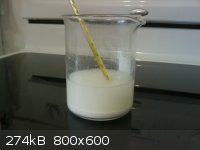 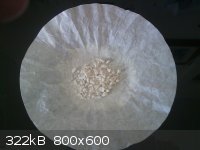
[Edited on 29-4-2011 by Hennig Brand]
|
|
|
Microtek
National Hazard
   
Posts: 827
Registered: 23-9-2002
Member Is Offline
Mood: No Mood
|
|
Well, Pb(OH)2 is extremely insoluble so any hydroxide in your NaN3 soln would give rise to lead hydroxide in your precipitate.
It really isn't much of a problem though; just adjust pH to close to neutral and you'll have a reasonably pure product. If you're worried about HN3,
use very dilute solutions. Not much HN3 will escape from a dilute solution and the heavy metal azides are so insoluble that you hardly lose any
product.
|
|
|
Hennig Brand
International Hazard
    
Posts: 1284
Registered: 7-6-2009
Member Is Offline
Mood: No Mood
|
|
Thanks Microtek. Have you ever recrystalllized NaN3, and if so what is a good solvent/method? I chose methanol just because it was cheap and abundant.
I suppose converting NaN3 to Pb(N3)2 is a pretty good purification method in itself if done properly.
BTW, I was using the name Hydrazine H2SO4 earlier in this thread. I had not been in my account for a while (maybe 8 months), and was having trouble
getting into it temporarily. With a little help I got back into it.
|
|
|
Formatik
National Hazard
   
Posts: 927
Registered: 25-3-2008
Member Is Offline
Mood: equilibrium
|
|
Re: Hydrazine poisoning
Be sure to read the medical report link to in the hydrazine thread. Mild hydrazine toxicity can be fought with vitamin B6 and lots of antioxidants.
The hydrazine headache could indicate liver damage already occurred, and then it can take a few days for some other effects to occur. Wear a
respirator, even with short exposure encounters with the material. A pair of gloves would be good too. Also wear clothes you don't like because
hydrazine leaves permanent groovy bluish turning pink stains on clothes.
|
|
|
Hennig Brand
International Hazard
    
Posts: 1284
Registered: 7-6-2009
Member Is Offline
Mood: No Mood
|
|
Thanks for the information. I think/hope my exposure was fairly mild. I have been avoiding alcohol to avoid a negative compounding effect on the
liver. The exposure was 15 days ago, and after about 7-8 days I started feeling mostly normal. I gotta say, I think a lot of my ill feelings came from
nerves and worry.
From now on I am going to be much more careful when around possible sources of hydrazine vapor.
I am not trying to down play the importance of safety with Hydrazine, but in decades past there must have been many people exposed to Hydrazine when
all the hazards were not well understood. I wonder what happened to them all.
If there was damage to the liver I hope it was just a bit of fibrosis and nothing that will cause cirrhosis. Fibrosis heals I have been told,
cirrhosis does not.
Silver Azide experiment:
On a more positive note, I followed Microteks advice and adjusted the pH of the NaN3 solution before adding the AgNO3 solution to it. It was hard to
tell exactly where neutral was, but I think I got it pretty close and the results speak for themselves. I was using some of those broad range pH test
papers.
I kept the solutions fairly dilute as suggested, using 1.3g of homemade NaN3 in 100mL of water and 15% HNO3. I added a couple drops of HNO3 with
swirling then checked the pH, by the time it was neutral I had added 8 drops. It maybe could have used another 1 or 2 drops.
Look at the nice white powder.
It actually picked up a tiny hint of grey just form the bit of light it was exposed to during filtering, etc.
Compare these pictures to the picture of my first attempt at AgN3, (half way down page 6 of this thread). White vs. dark grey.
I will use this routine the next time I make Pb(N3)2 as well.
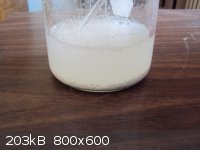 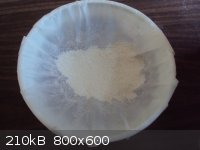
[Edited on 2-5-2011 by Hennig Brand]
|
|
|
Hennig Brand
International Hazard
    
Posts: 1284
Registered: 7-6-2009
Member Is Offline
Mood: No Mood
|
|
Hydrazine Sulfate storage question
I was wondering if it was better to store Hydrazine Sulfate or convert to Sodium Azide right away and store that? The assumption is that Azides are
the desired end products.
If someone could describe good storage practices for Hydrazine Sulfate and Sodium Azide I would be interested also.
I know I am asking things that could be looked up, but I also know that many people on the forum have worked with Hydrazine and Azides quite a bit and
have a good feel for things.
BTW, over on the Hydrazine thread I saw people saying that large glassware was not available to everyone and such and such. I looked around on the
internet a while back and I found several sites selling 5L erlenmeyers. Apparently 5L erlenmeyer flasks are very popular with the beer brewing crowd
to start yeast cultures. I think they normally went for around $40-$50, and were borosilicate glass.
Here is a picture of my large 5L erlenmeyer next to a 250mL erlenmeyer. Mine is older than the hills and was given to me. Since it is my largest piece
of glassware it gets a pet name, "Big Earl".
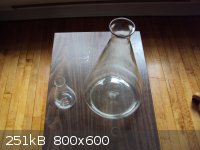
[Edited on 14-5-2011 by Hennig Brand]
|
|
|
quicksilver
International Hazard
    
Posts: 1820
Registered: 7-9-2005
Location: Inches from the keyboard....
Member Is Offline
Mood: ~-=SWINGS=-~
|
|
Opinion based on observation:
I have seen NaN3 stored in common chemical containers. Stored and sold as one would most other common lab chemical, in a tightly closed container
placed upon a shelf. However I have seen hydrazine sealed in a more resilient packaging. I would (were I to have a choice) bring hydrazine to an azide
for sake of storage.
If there was a need to maintain the hydrazine as a liquid, etc - I would store it with those characteristics I would use with acids & consider
breakage & fumes as priorities.
I once got a small refrigerator at a yard-sale from some dormitory for 10 dollars. I had often used that as it provided a semi-sealed & cold, dark
environment for a great many chemicals.
|
|
|
Hennig Brand
International Hazard
    
Posts: 1284
Registered: 7-6-2009
Member Is Offline
Mood: No Mood
|
|
I have seen Hydrazine and Hydrazine Hydrate in special containers, but Hydrazine Sulfate has always just been in regular dark colored, screw top glass
reagent bottles from what I have seen. I noticed the same thing about NaN3, just stored in regular dark colored regular screw top reagent bottles.
I just realized I left about 30g of Hydrazine Sulfate out on a filter paper for about 3 weeks. I actually meant to put it away about twenty times, but
somehow the time was never right. I am in the process of making some NaN3 with some of it, and I have to say it seems to perform quite normally. Will
have a yeild tomorrow which will probably tell the real story.
From what I have read Hydrazine Sulfate is a very stable and oxygen resistant form of Hydrazine. I have seen sources say that it is still degraded by
oxygen, but they never said to what exact extent, just that it was much less.
I will let you know what kind of yeild of NaN3 I get from the Hydrazine Sulfate that was exposed to the air for 3 weeks.
[Edited on 18-5-2011 by Hennig Brand]
|
|
|
PHILOU Zrealone
International Hazard
    
Posts: 2893
Registered: 20-5-2002
Location: Brussel
Member Is Offline
Mood: Bis-diazo-dinitro-hydroquinonic
|
|
Hydrazine and hydrazine hydrate are glass corrosive and sensitive to certain metals acting as catalyst of its decomposition...so colourised glass (by
metal oxydes) is doubly non suited!
[Edited on 18-5-2011 by PHILOU Zrealone]
PH Z (PHILOU Zrealone)
"Physic is all what never works; Chemistry is all what stinks and explodes!"-"Life that deadly disease, sexually transmitted."(W.Allen)
|
|
|
woelen
Super Administrator
        
Posts: 7976
Registered: 20-8-2005
Location: Netherlands
Member Is Offline
Mood: interested
|
|
I have some 64% hydrazine from a chemical supplier (Aldrich) and the hydrazine is stored in a brown glass bottle with a sturdy plastic screwcap and a
teflon liner inside the cap. A soft plastic ring is around the rim of the bottle in order to make a perfect seal when the screw cap is closed.
If companies like Aldrich sell hydrazine in glass bottles with sturdy caps, then I am inclined to think that the glass corrosiveness is not as bad as
people arte telling us. Of course, when distilling the material at higher temperatures things may become quite different, but on storage it seems
perfectly valid to have it in a glass bottle. Hydrazine is a weaker base than NH3, so I think that the glass corosiveness indeed is very weak.
Maybe pure hydrazine is more of a danger, but my 64% solution (the rest is water) seems perfectly stable. I already have it for a few years and have
no trouble at all.
|
|
|
| Pages:
1
..
5
6
7
8
9
..
18 |